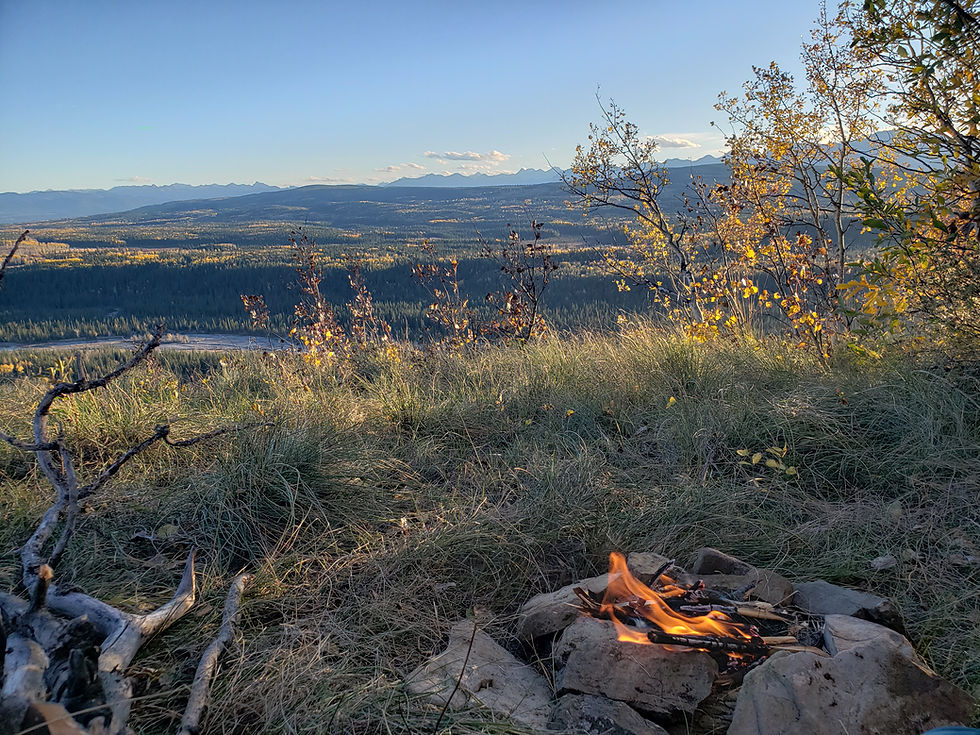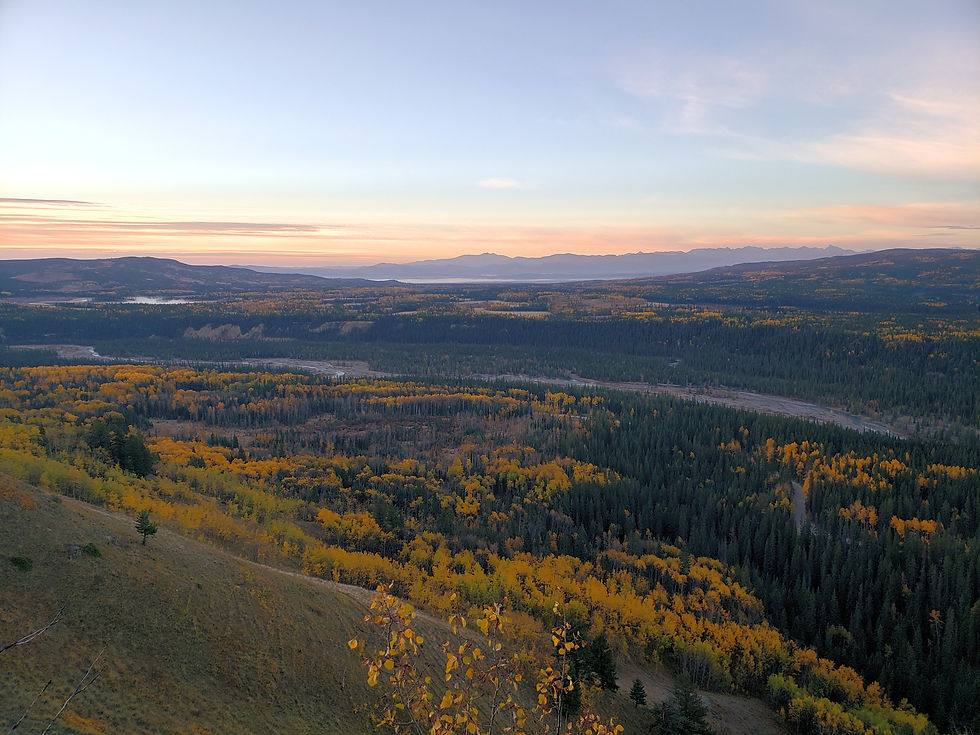Reflections on Education, Decolonization, and Indigenization
- Stuart Harden

- Oct 8, 2021
- 4 min read

I took this photograph last week before spending the night on a ridge near Lesueur Creek. With my partner out of town for a while, and needing to get out of my own head, I decided to go to a place where the rules allowed for camping, loose dogs, and backcountry fires. As I sat reflecting on the landscape I saw the Ghost River flowing from right to left below me. This waterway marks the boundary between the Ghost Public Land Use Zone and the Îyârhe (Stoney) Nakoda reserve. In that moment, as it does now, the river appeared as a boundary between myself and Indigenous people. It formed the edge between Indigenous and Settler worlds and worldviews. This border occupies my thought as I look toward my teaching practice.
As Poitras Pratt and her coauthors (2018) point out, we live in a place “divided by ongoing conflict, and fuelled by issues of power and control” (p. 2). The river represents one such divide. We in Canada are peoples divided by histories of conflict and ongoing struggles for land, power, and recognition. I see how Indigenous peoples have suffered from these conflicts and I see how I and my family are complicit in these struggles. Faced with these realities, I have through years of dialogue with Indigenous and Settler mentors worked to decolonize my own thinking and practices.
In the realm of schooling, Pratt et al. (2018) understand efforts toward decolonization as necessary steps toward the ultimate goal of Indigenizing education. Following Pratt’s path, I feel that I, both as an educator and a Settler Canadian, am graduating from a critical mission to a creative one, from the task of decolonization to a more constructive task—perhaps that of Indigenization. But what, I wonder, does it mean for a Settler to Indigenize? Pratt et al. (2018) offer that Indigenizing means, in educational contexts, “returning to the epistemological and ontological systems of a country’s Indigenous peoples in order to shape educational systems or institutions in that place” (p. 4). From my studies I have a basic familiarity with Cree, Stoney, and Mi’kmaq epistemological and ontological systems. Now the question is: how do I help expedite the return of these systems to schools? How do I help Indigenous ways of knowing and being to ford the Ghost River and expand beyond the reserve?

Several authors offer suggestions for a positive path forward. Pratt et al. (2018) are worth quoting at length as they describe an Indigenized pedagogy that unsettles Euro-American educational conventions of industrialization and standardization:
Education is ‘coming to know’ different levels of existence, and because of the constant flux that inspires renewal in all creation, education is an omnipresent life force that requires a lifetime process of answering: Who am I? Where do I come from? Where am I going? What are my responsibilities? Here, the intention is for humanity to walk and exist ‘in a good way’ within all of creation and with ‘all my relations.’ (p. 5)
Following this guidance, I should strive to make these questions, rather than specific curricular outcomes, the heart of my expositions and explorations with students. The prospect of leading this kind of learning excites me. But, like other pre-service teachers, I crave concrete skills and processes. Helpfully, Marie Battiste (2013) offers three practical pillars of Indigenous education; she sates that, “the distinctive features of Indigenous knowledge and pedagogy are learning by observation and doing, learning through authentic experiences and individualized instruction, and learning through enjoyment” (pp. 178-79). I am optimistic that both the overarching questions posed by Pratt et al. (2018) and the methods and attitudes espoused by Battiste (2013) will fit well into my future practice and the practices of other teachers.
Importantly, I am not restricted to learning and educating in isolation with only texts to guide me. The river is not impassable. The possibility—indeed, the need—to form intercommunal relationships is pressing. Despite our divisions, even now we sit on the same land and under the same sky. If our ultimate intention as educators is, as Pratt et al. (2018) state, “for humanity to walk and exist ‘in a good way’ with all of creation,” (p. 5), then we are all able to at least begin to Indigenize our ways by looking to the land and all of creation for lessons. Leanne Betasamosake Simpson (2014) seems to endorse this accessible vision of education; she writes, “this is how our old people teach. They are our geniuses because they know that wisdom is generated from the ground up, that meaning is for everyone, and that we’re all better when we’re able to derive meaning out of our lives and be our best selves” (pp. 8-9). Properly understood, education is therefore available to anyone who has the goodwill and the guidance to make life-affirming meaning out of the world and its web of relationships. Land, in this version of education, becomes a common mentor alongside particular human mentors.

A final word on human mentors; I know that at this point in my career I am in need of human mentorship. Mentorship is something I have up to now (for reasons personal or cultural) failed to cultivate. I must move my focus from the work of decolonizing and knowledge building to the work of relationship building. Returning to the photograph of the Ghost, I can imagine a north wind urging the fire (and me with it) south over the river towards the community of Mînî Thnî (Morley). I must follow the wind across the river, I must commit myself to relational work and seek out guidance.
Camping like this in the Ghost gives the feeling of acting outside of received rules and institutions. In this place one has to be a careful fire tender. Embers must be watched around dry grass. Similarly, when I depart from conventional (read: colonial) ways of doing things, of living and educating, I have to act with deliberation and humility. I should not charge into the forest and light a bonfire. Better yet, I should share my fire with others.
References
Battiste, M. (2013). Chapter 10: Possibilities of Educational Transformations. In Decolonizing Education: Nourishing the Learning Spirit
Betasamosake Simpson, L. (2014). Land as pedagogy: Nishnaabeg intelligence and rebellious transformation. Decolonization: Indigeneity, Education & Society, 3(3), 1–25.
Poitras Pratt, Y., Louie, D. W., Hanson, A. J., & Ottmann, J. (2018). Indigenous Education and Decolonization. In Y. Poitras Pratt, D. W. Louie, A. J. Hanson, & J. Ottmann, Oxford Research Encyclopedia of Education. Oxford University Press. https://doi.org/10.1093/acrefore/9780190264093.013.240
Comments